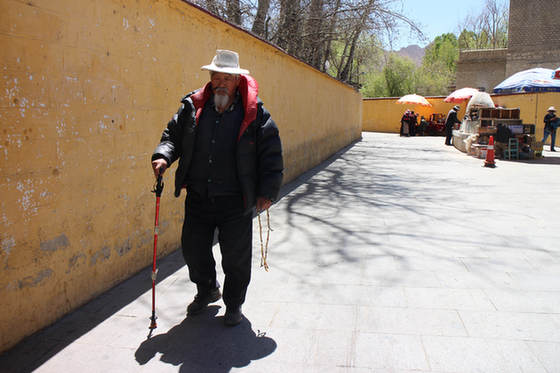A Homecoming
By staff reporter LI GUOWEN
I first met Dorje Tseten on his daily circumambulation, the ritual of circling a Tibetan Buddhist holy site and praying, along Lingkhor, the sacred path in Lhasa, capital of Tibet Autonomous Region. While he no longer has the agility of his youth, the 84 year old insists on performing his prayer wheel ritual every day. On completion he takes the bus home. “I have the card for senior citizens that entitles me to free bus travel,” he said.
 |
|
Dorje Tseten performs his daily circumambulation. Li Guowen |
Dorje Tseten returned to Lhasa from a decades-long exile in 1999. He left Tibet in 1959 and lived for almost 40 years as a displaced person in India before coming back to his homeland 15 years ago. With his rich experience, the octogenarian is a true witness to pivotal changes in Tibetan history.
Dorje Tseten was from a “Tralpa,” or serf, family, who were forced to cultivate the land owned by the local government or serf owners. “My family and I were busy from dawn to dusk every day, but were still dirt poor,” he recalled.
In 1951, the People’s Liberation Army (PLA) entered Tibet. Dorje Tseten had heard that the PLA was good to ordinary folk. “At that time, we heard rumors that many soldiers of the 18th Corps of the PLA had died during construction of the new road in Tibet and that the nobility did not offer any help,” Dorje Tseten said. But, in 1959 a riot erupted in Tibet under the incitement of a small group of nobles. In the panic and chaos Dorje Tseten and other ill-informed Tibetans fled China.
Destitution in India
Recalling the 1959 riot, Dorje Tseten says, “The society fell suddenly into disarray. Rumors that the Han people were on a mission to kill Tibetans filled the air, so many people chose to escape from Tibet. When we arrived in a refugee camp at the China-Indian border, we found that while the nobles there were well tended to by their servants, we ordinary people were ill-prepared. We had nothing to protect ourselves from the muggy weather, or deal with the different food and language. After living in the camp for several months with minimal support from the international community, many of the weak and poor died.” Having no money, the only way Dorje Tseten could survive was by exchanging his jewelry for food.
Aged 29, Dorje Tseten was a man in his prime during the period of his exile. Healthy and strong, he was recruited from the refugee camp by Indian officials to build new roads in a high altitude region. The working conditions were harsh and food was rationed. When the work was completed a military officer chose him to be his coachman. Dorje Tseten worked for the young master for two years in the officer’s hometown of Darjeeling. “ When the young master left for further education in Britain, he asked his father to find me a carpentry job in the family factory,” Dorje Tseten recalled. “A year later, I was employed as a carpenter by the ‘Tibetan Children’s Village,’ a school in Shimla, India.”
